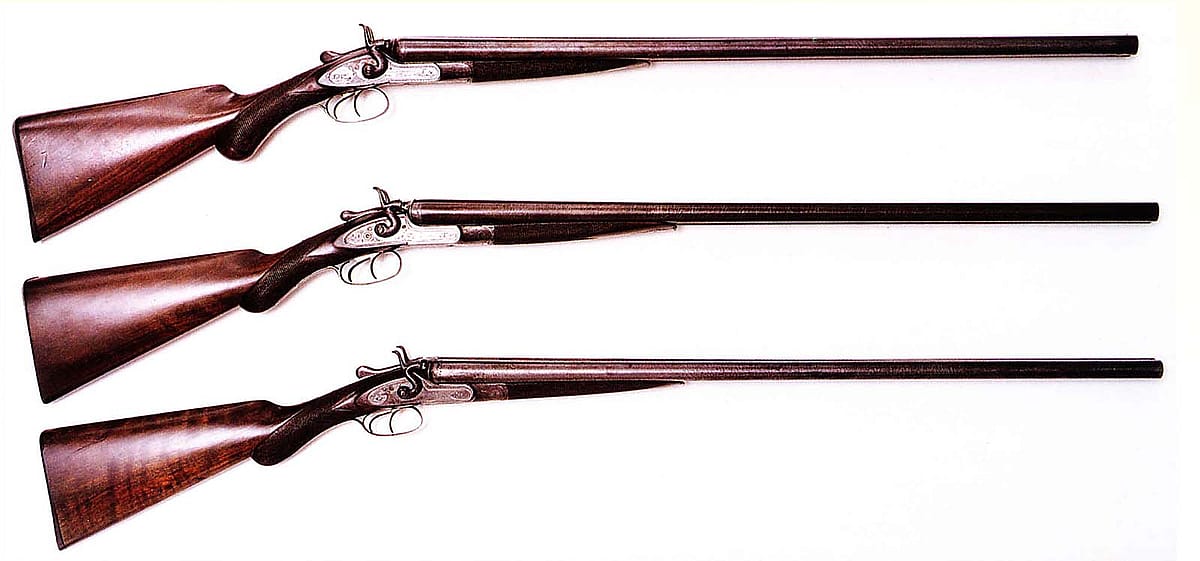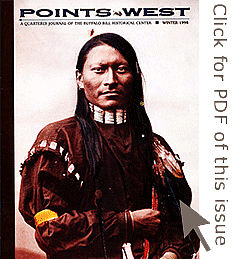
Winchester’s English Shotguns – Points West Online
Originally published in Points West magazine
Winter 1998
Winchester’s English Shotguns: A Marketing Maneuver with Lasting Influence
By Herbert G. Houze
While it is now common practice for companies to sell products under their own tradename that are in fact made by other concerns, the phenomenon is generally regarded as being a fairly recent innovation. Or is it?
During the late eighteenth and throughout the nineteenth centuries London gunmakers routinely marketed arms under their own proprietary names that were built by subcontractors in Birmingham or elsewhere in Europe. Likewise many American gunmakers of the same period, such as Constable in Philadelphia, Haslett in Baltimore and the Moore family in New York City, followed suit. Though it has been argued that these makers, as well as others, simply used foreign-made parts to assemble firearms, various custom house records indicate they were importing fully finished arms from Great Britain and Europe. As the American arms industry matured and became heavily industrialized, the reliance upon foreign sources for gun parts gradually diminished. Some custom gunmakers, however, continued to use English-made locks in the rifles or pistols they produced until almost the end of the nineteenth century. For the most part these makers believed that the handmade English product possessed a greater sureness of fire than its mass-produced American cousin—a point that had some validity given the uneven quality found in American products of the time.
With the rise of American pride in its industrialized arms industry after Samuel Colt’s effort at the London International Exhibition of 1851, foreign-made arms became increasingly viewed as inferior to those made within the borders of the United States. This impression grew and spread throughout the 1850s, 60s, and 70s to the point that foreign arms were viewed with almost universal disdain by American sportsmen. To many, the growing importance of the American arms industry found its best expression in the displays set up by firms such as Colt, Remington, Smith & Wesson, and Winchester at the 1876 Centennial Exposition held in Philadelphia. The varied nature and uniform high quality of their product lines assured the public that American arms had no equals. Thus, it would appear to be somewhat of an anomaly that a mere four years later the Winchester company began importing English shotguns for sale under their name in New York City.
The reasons for the Winchester company’s actions were purely economic. Having established a dominant position within the repeating rifle market, the firm wanted to expand its influence into other areas. Recognizing that the dynamics of the arms trade were rapidly changing and that the demand for double barrel shotguns would soon exceed the production capabilities of those American companies manufacturing such arms, Winchester’s management decided to aggressively attack that market. Though Winchester could have easily built its own shotguns, the costs of developing and then tooling up for such a new model would have been both cost prohibitive and time consuming. As he had been advised that conditions were ripe to take over the market, Oliver F. Winchester decided that the simplest expedient was to import first quality shotguns from abroad. Consequently, in early 1880 Winchester entered into an agreement with Christopher G. Bonehill of Birmingham to produce double barrel shotguns bearing the name of the Winchester Repeating Arms Company. Sold through the company’s New York City Depot, these shotguns retailed for prices between $40 and $85—not insignificant amounts for the period (as a point of comparison a Colt Model 1873 Single Action Army Revolver sold for approximately $20 at that time). In 1881, the Winchester company changed contractors and began purchasing shotguns made by Richard Redman of Birmingham. Though of the same design and quality, Winchester was able to sell Redman’s shotguns for considerably less (from $36.50 to $66.50) than Bonehill’s shotguns. In addition, the company began marketing even lower-priced English shotguns by other makers.

Needless to say, neither E. Remington & Sons nor the Colt’s Patent Fire Arms Manufacturing Company was pleased by Winchester’s incursions into what they had considered their own markets. While Remington was not in a financial position to retaliate, Colt was and did. It announced plans to introduce a new repeating lever action rifle to challenge Winchester’s position within that market and launched a vocal “Buy American” campaign to discredit its competitor. In turn Winchester began importing inexpensive P. Webley & Sons double-action revolvers to sell in New York. The trade war between the two giants worsened during 1883 when Winchester let it be known that it would begin production of its own single-action revolver (to compete with the Colt Model 1873) and a slide action rifle (to compete with one that Colt was planning to produce).
By early 1884, however, Winchester’s management had decided that a quick strike was necessary to diffuse any future fighting between it and Colt. In a masterful bit of subterfuge, T.G. Bennett, Winchester’s vice president, set up a meeting with Major General William B. Franklin, general manager and vice president of the Colt company for June 1, 1884. Two weeks prior to that meeting Winchester sold its entire remaining stock of English shotguns (some 1,356 arms) to the New York dealer J.P. Moore & Sons at a loss. Having effectively flooded the New York market with inexpensively priced shotguns to further depress Colt’s profit margins, Bennett then went to Hartford and showed Franklin working models of Winchester’s new revolver, as well as slide action rifle. Though the content of their meeting is not known, Bennett wrote in his diary that night that the two companies had reached an “agreement not to interfere in the other’s markets.” The Colt company subsequently withdrew its Burgess lever action rifle from the market and Winchester dropped its plans to begin production of a single action revolver. The two firms did compete peacefully in the slide action rifle market after the introduction of the Winchester Model 1890, but they never again came head-to-head in the shotgun market.
About the author
Herbert G. Houze was a former curator of the Cody Firearms Museum at the Buffalo Bill Center of the West. He later served as Curator Emeritus of the Winchester Arms Collection and the Cody Firearms Museum from 2016 until his death in August 2019.
Post 066
Written By
Nancy McClure
Nancy now does Grants & Foundations Relations for the Center of the West's Development Department, but was formerly the Content Producer for the Center's Public Relations Department, where her work included writing and updating website content, publicizing events, copy editing, working with images, and producing the e-newsletter Western Wire. Her current job is seeking and applying for funding from government grants and private foundations. In her spare time, Nancy enjoys photography, reading, flower gardening, and playing the flute.










